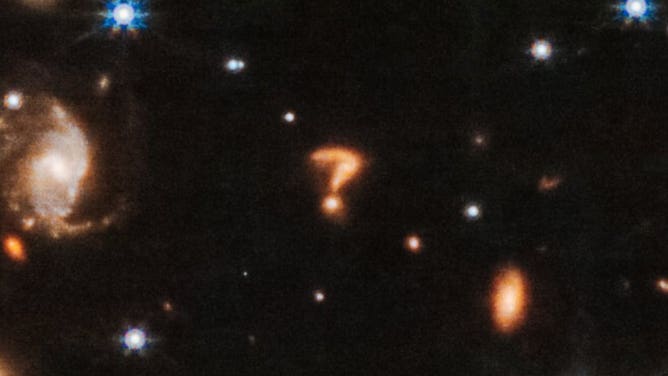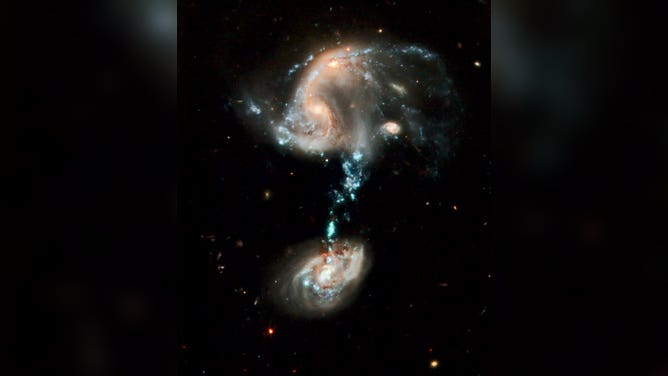Telescope spots giant question mark floating around the cosmos
According to the European Space Agency, the imagery depicts a pair of galaxies merging together. The upper part of the question mark-looking figure could be a distorted spiral galaxy, merging with a second galaxy.
Rarely seen prelude to supernova captured by James Webb Space Telescope
The luminous, hot star Wolf-Rayet 124 (WR 124) is prominent at the center of the James Webb Space Telescope’s composite image combining near-infrared and mid-infrared wavelengths of light from Webb’s Near-Infrared Camera and Mid-Infrared Instrument.
Imagery of a giant question mark floating around the cosmos has caused a stir on social media, but experts at the European Space Agency said there is an explanation for what the James Webb Space Telescope picked up on many light-years away.
According to space experts, the giant question mark is actually a pair of galaxies merging together, with the upper region being distorted.
The odd-looking feature was spotted in imagery taken of stars named Herbig-Haro 46/47, which have been studied since the 1950s, but it is only with the addition of new technology that researchers have been able to examine features with better definition.
According to the agency, most of the fiery orange material is believed to be gasses and dust that have surrounded stars over thousands of years.
SEE THE OBJECTS HUMANS LEFT BEHIND ON THE MOON

The NASA/ESA/CSA James Webb Space Telescope captured detailed infrared imagery of forming stars.
(European Space Agency / FOX Weather)
The James Webb Space Telescope has made a series of stunning discoveries during its over-year-long excursion in space, leading to striking imagery of galaxies, nebulas and other faraway features.
Scientists say the Webb has exceeded expectations and believe the high-tech instrument is just getting warmed up with at least 20 more decades left in its lifecycle.
The ESA compared the recent image to that of one that was created in 2009 with the help of the Hubble Space Telescope.
In the image, galaxies PGC 37639 and PGC 101374 appeared to be playing galactic tug-of-war and formed a similar shape to that of a question mark.
NASA DEVELOPS "MOON DUSTER" TO ZAP AWAY LUNAR DUST

Telescopes captured detailed infrared imagery in 2009.
(European Space Agency / FOX Weather)
"The blue stream is thought to have formed through the turbulent gravitational interactions occurring at the top of the frame — the uppermost galaxy clump is a whirl of flailing once-spiral arms. The stream is some 100,000 light-years long, and made up of gas, dust and many millions of newborn stars. These stars, which are clumped together to form star clusters, which in turn later accumulate as superclusters, are responsible for the striking blue hue visible here. They are mostly young, hot and massive, a combination that causes them to emit blue light," the ESA said.
The space agency does admit more observations are needed to better understand the phenomena, and with tools such as the Webb now in operation, scientists are expected to make more stunning observations.
